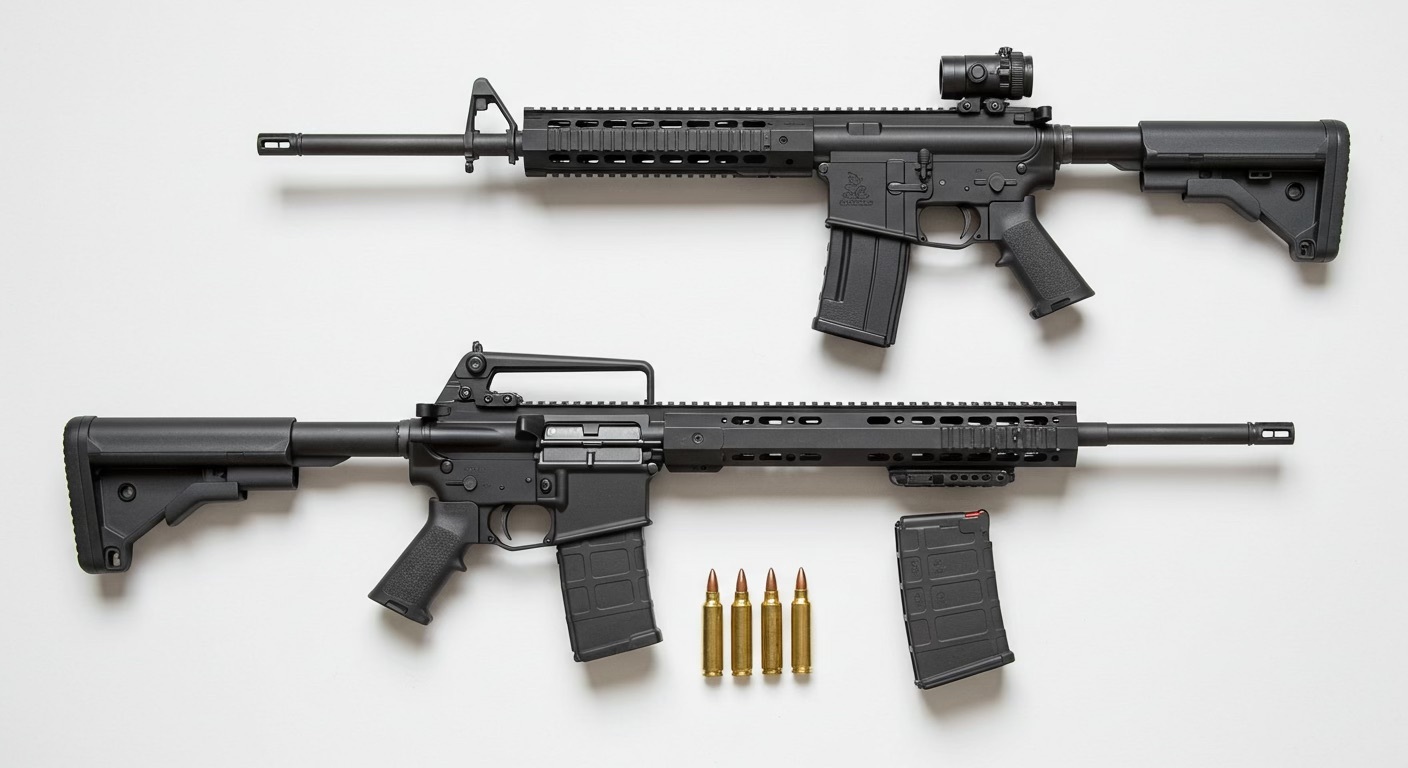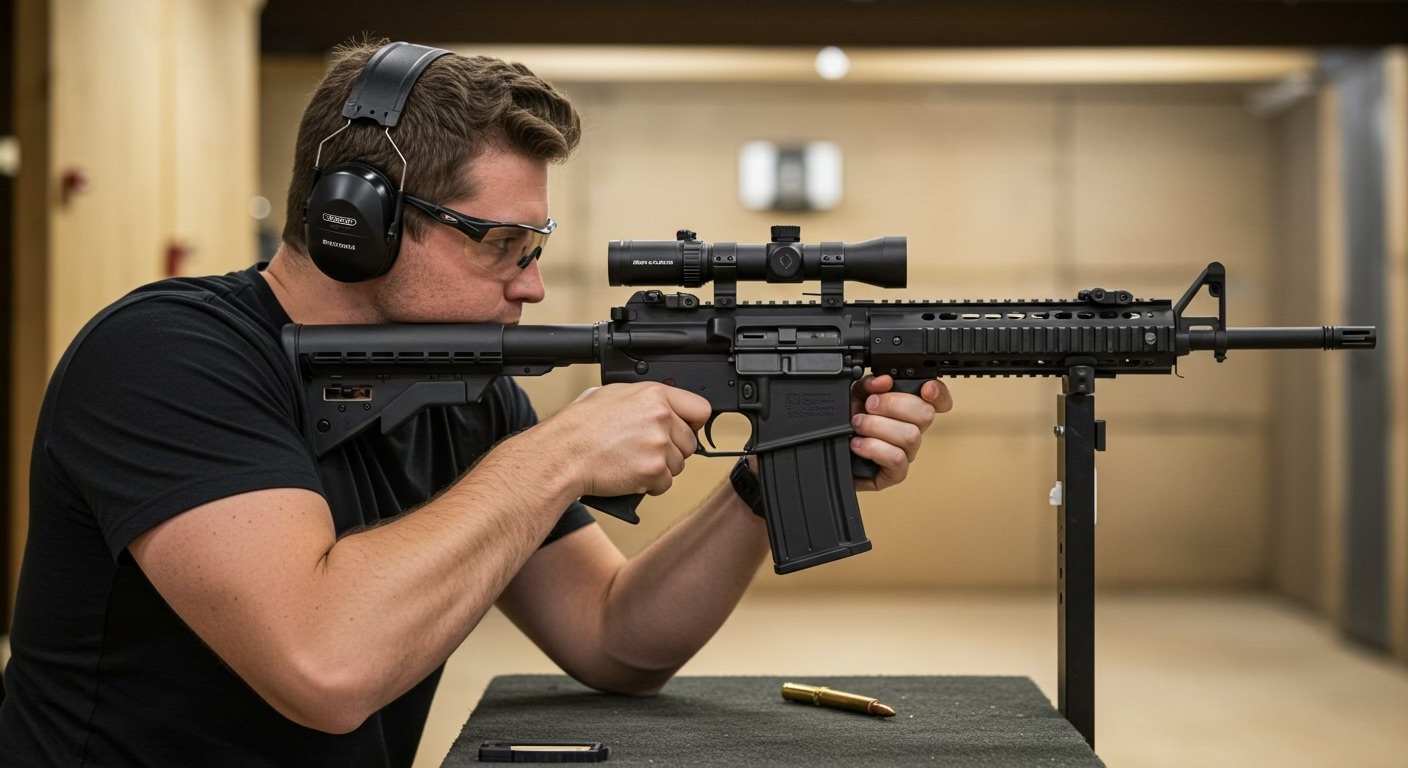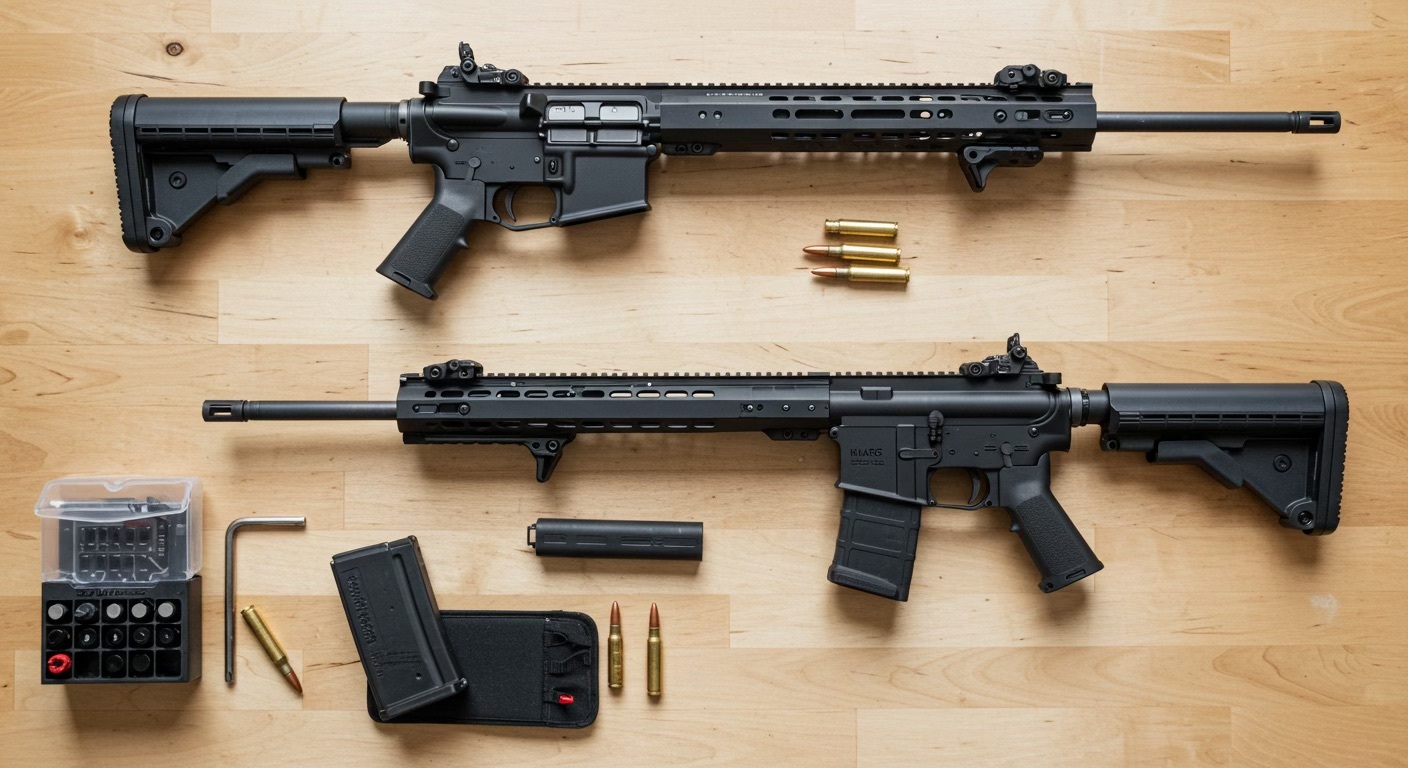When it comes to precision shooting and long-range performance, caliber selection can make all the difference between hitting your target consistently or missing the mark. The debate between the 22 ARC and 6.5 Creedmoor has gained significant traction among shooting enthusiasts and hunters alike.
Both calibers offer impressive ballistic performance, but they serve different purposes and excel in distinct shooting scenarios. Understanding the key differences between these popular cartridges will help you make an informed decision that aligns with your shooting needs.
Whether you're building a custom AR platform with components from AR15 Parts or selecting a bolt-action rifle, this comprehensive comparison will provide you with the critical insights needed to choose between these two formidable calibers.
Understand the Purpose Behind Each Cartridge’s Development
The 6.5 Creedmoor and 22 ARC represent different eras in modern cartridge development, each created to solve specific ballistic challenges. The 6.5 Creedmoor was developed in 2007 by Hornady, specifically designed for competitive long-range shooting.
It was created to improve upon existing cartridges by offering superior long-range ballistics with manageable recoil. The design team, led by Dave Emary and Dennis DeMille, focused on creating a cartridge that would maintain supersonic velocity at extended ranges while fitting in a short-action rifle.
By 2009, the 6.5 Creedmoor had already begun making waves in competitive shooting circuits. In contrast, the 22 ARC (Advanced Rifle Cartridge) is a more recent development, introduced to provide AR platform shooters with enhanced long-range capability without requiring significant modifications to the rifle.
It was designed to bridge the gap between the popular .223 Remington/5.56 NATO and larger calibers like the 6.5 Creedmoor, offering improved ballistic performance while maintaining compatibility with standard AR components.
Both cartridges have found their place in the shooting world, with the 6.5 Creedmoor becoming something of an industry standard for precision rifles, while the 22 ARC continues to gain popularity among shooters looking for an optimized AR platform solution from retailers like AR15 Parts.
Compare Ballistics to Choose the Best Fit for Your Range
When comparing the 22 ARC and 6.5 Creedmoor, ballistic performance represents one of the most significant differentiating factors between these two cartridges. The 6.5 Creedmoor typically fires bullets weighing between 120 and 147 grains, with muzzle velocities ranging from 2,700 to 2,900 fps depending on the load.
This combination results in impressive downrange performance, with the cartridge maintaining supersonic flight beyond 1,400 yards in optimal conditions. The 6.5mm bullets feature exceptional ballistic coefficients, which translates to minimal wind drift and excellent energy retention at distance.
The 22 ARC, utilizing .224" diameter bullets typically weighing between 60 and 80 grains, produces velocities between 2,750 and 3,000 fps from standard barrel lengths. While these lighter bullets don't retain energy as well as heavier 6.5mm projectiles, they offer flatter trajectories at medium ranges and significantly less recoil.
For practical comparison, consider these ballistic differentiators:
- At 500 yards, a 140-grain 6.5 Creedmoor load typically drops about 45-50 inches, while a 75-grain 22 ARC might drop 55-60 inches
- With wind drift at 500 yards in a 10mph crosswind, 6.5 Creedmoor sees approximately 11-13 inches of drift compared to 16-19 inches for the 22 ARC
- With regards to energy retention at 500 yards, 6.5 Creedmoor retains roughly 1,200-1,400 ft-lbs versus 500-650 ft-lbs for the 22 ARC
These ballistic characteristics make the 6.5 Creedmoor generally superior for extended long-range shooting, while the 22 ARC offers excellent performance for medium ranges with minimal recoil and flatter trajectories at distances under 400 yards.
Match Each Caliber with the Ideal Rifle Setup

Understanding which platforms work best with each caliber is crucial for making the right selection for your specific needs.
The 6.5 Creedmoor was primarily designed for bolt-action rifles, particularly those with short actions. It has become incredibly popular in precision rifle competitions using chassis systems from manufacturers like Accuracy International, Tikka, and Bergara.
While initially centered on bolt guns, the cartridge has successfully transitioned to semi-automatic platforms, including AR-10 pattern rifles and other .308 Winchester-based systems. The 6.5 Creedmoor requires a larger receiver than standard AR-15 platforms due to its case dimensions.
The 22 ARC, by contrast, was specifically developed to function within the AR-15 platform. It can utilize standard AR-15 lower receivers with specialized upper assemblies like the 18" 6MM ARC Complete Upper - Satern Medium SS. This compatibility makes it an attractive option for those who already own AR-15 rifles and want enhanced ballistic performance without investing in an entirely new system.
Key platform considerations include:
- Magazine Compatibility: 6.5 Creedmoor uses .308/7.62 NATO magazine patterns, while 22 ARC requires specific magazines different from standard 5.56 options.
- Barrel Options: Both calibers benefit from specific twist rates optimized for their bullet weights.
- Gas System Requirements: 22 ARC typically functions best with mid-length or rifle-length gas systems in AR platforms.
- Bolt Requirements: 22 ARC uses specialized bolts different from standard 5.56/.223 bolts.
For those looking to build or upgrade a rifle, components like the 18" 6MM ARC Barrel - Ballistic Adv - SPR represent quality options that optimize performance for that specific caliber.
Choose the Right Caliber for Hunting or Competition
Both the 22 ARC and 6.5 Creedmoor excel in different applications, making your intended use a critical factor in choosing between them.
The 6.5 Creedmoor has established itself as a versatile cartridge suitable for:
- Long-range competitive shooting out to 1,200+ yards
- Medium to large game hunting (deer, elk, antelope) at ranges up to 500+ yards
- Tactical and precision rifle applications that require consistent accuracy
- Military and law enforcement precision roles
Its combination of manageable recoil, excellent accuracy, and significant downrange energy makes it particularly well-suited for hunters who may need to take longer shots on medium-sized game. The terminal ballistics of the 6.5mm bullets, particularly those designed for hunting, deliver consistent expansion and penetration at extended ranges.
The 22 ARC serves different but equally valuable purposes:
- Medium-range precision shooting (300-600 yards)
- Smaller game hunting (coyotes, prairie dogs, smaller deer)
- Competitive shooting disciplines that do not require extreme long-range performance
- Training platform for shooters transitioning to precision shooting
The 22 ARC's mild recoil makes it particularly appealing for shooters sensitive to recoil or those who want to observe their impacts through the scope. This feature, combined with lower ammunition costs compared to the 6.5 Creedmoor, makes it an excellent option for high-volume practice sessions.
For hunters, the selection largely depends on the target game and typical engagement distances. The 6.5 Creedmoor offers better terminal performance on larger animals, while the 22 ARC provides exceptional accuracy with minimal meat damage on smaller game.
Factor in Ammo Cost and Availability Before Buying
Ammunition considerations often play a decisive role when selecting these calibers, affecting initial and ongoing ownership costs. The 6.5 Creedmoor has experienced tremendous commercial success, resulting in wide ammunition availability from virtually all major manufacturers.
Practice ammunition typically ranges from $1.20-$1.75 per round, while premium hunting and match-grade loads can cost between $2.00-$3.50 per round. The widespread availability means 6.5 Creedmoor ammunition can be found in most sporting goods stores and gun shops nationwide, not just specialty retailers.
The 22 ARC, being newer to the market, has more limited factory ammunition options, though this is expanding as the cartridge gains popularity. Current pricing typically runs from $1.10-$1.40 for practice ammunition and $1.75-$2.50 for premium loads. The relative newness of the cartridge means availability may be spotty in physical retail locations, making online retailers more reliable sources.
For reloaders, both cartridges offer advantages:
- Component availability (brass, bullets, data) is excellent for 6.5 Creedmoor
- The 22 ARC uses widely available .224" bullets shared with many popular cartridges
- The 6.5 Creedmoor typically requires less powder per load than larger cartridges
- 22 ARC brass life tends to be very good with proper loads, often exceeding 8-10 reloadings
Long-term cost projections favor the 22 ARC for high-volume shooters, with approximately 15-25% lower per-round costs compared to 6.5 Creedmoor when considering both factory ammunition and reloading expenses.
Consider Recoil for Better Shooting Comfort

Recoil management significantly impacts shooting enjoyment, accuracy potential, and the shooter's ability to spot their impacts.
The 6.5 Creedmoor produces moderate recoil that most shooters find manageable, but still noticeable. In a typical 8-pound rifle, the 6.5 Creedmoor generates approximately 12-14 ft-lbs of recoil energy with standard loads.
This level of recoil allows for relatively quick follow-up shots while remaining comfortable enough for extended shooting sessions. Shooters transitioning from .308 Winchester or similar cartridges typically find the 6.5 Creedmoor offers a noticeable reduction in felt recoil.
The 22 ARC delivers significantly milder recoil impulse, generating only about 4-6 ft-lbs of recoil energy in a similar weight rifle. This minimal recoil profile creates several advantages:
- Easier spotting of impacts through the scope
- Reduced shooter fatigue during extended sessions
- More comfortable experience for recoil-sensitive shooters
- Better suited for introducing new shooters to centerfire rifles
For precision shooting applications, the reduced recoil of the 22 ARC can translate to better shot-to-shot consistency, particularly for shooters still developing their fundamentals. The minimal muzzle rise allows for faster target reacquisition and follow-up shots.
However, the 6.5 Creedmoor's additional recoil comes with the benefit of significantly more downrange energy, making the trade-off worthwhile for those needing the terminal performance on larger game or consistent hits at extreme distances.
Frequently Asked Questions
Which caliber is better for a first-time precision rifle owner?
For first-time precision rifle owners, the 6.5 Creedmoor generally offers the best balance of performance and accessibility. Its widespread commercial support means more available ammunition options, extensive load data, and abundant factory rifle choices.
The moderate recoil is manageable for most shooters while still providing excellent long-range capability. The 22 ARC is an excellent alternative for those specifically looking to build on the AR platform who prioritize minimal recoil and don't require the extended range capability of the 6.5 Creedmoor.
How does barrel life compare between the 22 ARC and 6.5 Creedmoor?
The 6.5 Creedmoor typically offers a barrel life of approximately 2,000-3,000 rounds before noticeable accuracy degradation occurs with match-grade ammunition. High-volume shooters may see throat erosion begin earlier, particularly with hot loads.
The 22 ARC generally provides longer barrel life, with many shooters reporting 3,000-4,000 rounds before similar accuracy degradation. This extended barrel life represents a significant advantage for high-volume shooters, as barrel replacement costs can be substantial over time.
Can the 6.5 Creedmoor be used effectively in an AR platform?
Yes, the 6.5 Creedmoor can be used effectively in AR platforms, but it requires an AR-10/LR-308-sized receiver rather than a standard AR-15. Several manufacturers offer excellent AR-pattern rifles chambered in 6.5 Creedmoor that deliver outstanding accuracy.
However, these rifles are typically heavier and more expensive than their AR-15 counterparts. For those specifically wanting an AR-15-sized rifle with enhanced ballistic performance, the 22 ARC represents a better option that doesn't require the larger receiver.
Which caliber is more economical for regular practice?
The 22 ARC is generally more economical for regular practice. Factory ammunition typically costs 15-25% less than comparable 6.5 Creedmoor offerings, and the cost advantage increases further for reloaders.
The 22 ARC uses less powder per load and utilizes widely available .224" bullets shared with popular cartridges like .223 Remington and .22-250. The reduced barrel wear with the 22 ARC also translates to lower long-term maintenance costs for high-volume shooters.
At what distance does the 6.5 Creedmoor gain a significant advantage over the 22 ARC?
The 6.5 Creedmoor begins to show significant advantages over the 22 ARC at approximately 500-600 yards, with the gap widening substantially beyond 700 yards. At these extended ranges, the superior ballistic coefficients of 6.5mm bullets result in significantly less wind drift, flatter trajectories, and substantially more retained energy.
For shooters primarily operating inside 500 yards, the performance difference is less pronounced, making the 22 ARC a viable and often preferable option due to its reduced recoil and lower operating costs.
Making the Right Choice for Your Shooting Needs

When deciding between the 22 ARC and 6.5 Creedmoor, your specific shooting requirements should guide your selection. Both calibers represent excellent options supported by quality components available from specialized retailers like us.
The 6.5 Creedmoor excels at long-range precision with moderate recoil and exceptional ballistic performance beyond 500 yards, making it ideal for competitors and hunters pursuing medium to large game at extended distances.
Meanwhile, the 22 ARC offers an outstanding balance of performance and shootability in a platform compatible with AR-15 components, delivering minimal recoil and excellent accuracy at medium ranges. By carefully evaluating your intended use, shooting distances, recoil preferences, and budget considerations, you can select the caliber that best aligns with your shooting goals.
Contact AR15 Parts for the Right Caliber Components
At AR15 Parts, we’re committed to helping shooters get the most from their rifles, whether you're upgrading a 6.5 Creedmoor setup or building a new 22 ARC platform. We offer premium components, expert support, and proven performance across the board.
Reach out to AR15 Parts today to explore caliber-specific builds, get expert recommendations, and ensure your rifle is equipped with parts that match your performance goals and shooting style.

